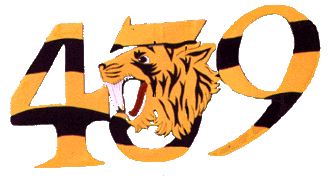|
History
of
 Squadron Squadron
  
Chapter
VI
Winter in the Netherlands
November 1944 January
1945
A slight improvement in the weather the next afternoon permitted four pilots led by F/L John Carr to get away on a
"pukka" rhubarb. The unusually vivid report of the sortie
ran: "The boys set course over base at a very low altitude, heading for
Nijmegen. On approaching the bomb line, they went down to zero feet at a speed of 300 m.p.h. After flying in a northerly direction past Nijmegen for two minutes, the flight changed course onto an easterly heading for the Coesfeld area. The aircraft kept right on the deck and at times snow was blown up by the propeller wash. The Jerry radar was unsuccessful in plotting their course until the boys pulled up to
avoid some high tension wires. Then the familiar ringing noise of German radar was noticed over the R/T, only to be lost when the aircraft went down to deck level again. While on course, a marshalling yard came into view, where short bursts were given. Heavy flak came up, but nothing to cause any harm. The boys then saw the marshalling yards of Coesfeld ahead, and pulled up to 6000 feet; the weather was quite good in this area. A train was noticed south of
Dulmen, travelling south west with steam up and pulling about 20 freight cars. The locomotive was left a flamer with five TRGs (freight cars) damaged. Some 40mm. was firing, but it was not intense. The lads then climbed and, as no other movement was noticed, the flight set course for base at 10,000 feet. There was
9/10ths low lying cloud on the way back, but on crossing the bombline the cloud formation broke and the boys reached base safely."
|
Intentionally
left blank
|
Intentionally
left blank
|
On the 28th one
formation which went out rail cutting found the target area blotted out by low cloud. To the west, however, Blue section found a hole through which they dived to blow a gap in the Coesfeld Dorsten line. Red
section, unable to find a break in the clouds near the rails,
bombed en alternative target, the barracks at Lembeck. No results were observed. The next operation promised to be interesting, as John Carr's section proposed to strafe an airfield near Munster from which jets had been operating. Unfortunately, the clouds intervened, and unable to find a break in the overcast the four pilots had to return. The homeward flight through the clouds was rather nerve wracking. The same bugbear
foiled another recce which
Carr attempted on the afternoon of the 29th; several let downs were made in a vain attempt to find a clear spot in the tactical area.
|
  
Copyright
©1998-2016 Michael T. Melnick. All rights reserved
the
unofficial homepage of  Tiger
Squadron Tiger
Squadron
.
.
|
|